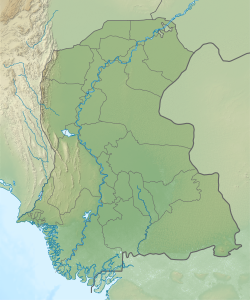 | |
| Location | Larkana District, Sindh, |
|---|---|
| Coordinates | 27°19′45″N 68°08′20″E / 27.32917°N 68.13889°E |
| Type | Settlement |
| Area | 250 ha (620 acres)[1] |
| History | |
| Founded | 26–25th century BCE |
| Abandoned | 19th century BCE |
| Cultures | Indus Valley Civilisation |
| Official name | Archaeological Ruins at Moenjodaro |
| Criteria | Cultural: ii, iii |
| Reference | 138 |
| Inscription | 1980 (4th Session) |
| Area | 240 ha |
Mohenjo-daro (/moʊˌhɛndʒoʊ ˈdɑːroʊ/; Sindhi: موهن جو دڙو, lit. 'Mound of the Dead Men'; Urdu: موئن جو دڑو [muˑənⁱ dʑoˑ d̪əɽoˑ]) is an archaeological site in Larkana District, Sindh, Pakistan. Built c. 2500 BCE, it was the largest settlement of the ancient Indus Valley Civilisation, and one of the world's earliest major cities, contemporaneous with the civilizations of ancient Egypt, Mesopotamia, Minoan Crete, and Norte Chico.[2][3]
With an estimated population of at least 40,000 people, Mohenjo-daro prospered for several centuries, but by c. 1700 BCE had been abandoned,[4] along with other large cities of the Indus Valley Civilization.
The site was rediscovered in the 1920s. Significant excavation has since been conducted at the site of the city, which was designated a UNESCO World Heritage Site in 1980, the first site in South Asia to be so designated.[5] The site is currently threatened by erosion and improper restoration.[6]
- ^ Crispin Bates; Minoru Mio (22 May 2015). Cities in South Asia. Routledge. ISBN 978-1-317-56512-3.
- ^ Mohenjo-Daro (archaeological site, Pakistan) on Encyclopedia Britannica website Retrieved 25 November 2019
- ^ Gregory L. Possehl (11 November 2002). The Indus Civilization: A Contemporary Perspective. Rowman Altamira. p. 80. ISBN 978-0-7591-1642-9.
- ^ Shea, Samantha (14 November 2022). "Pakistan's lost city of 40,000 people". www.bbc.com. Retrieved 18 November 2022.
- ^ "Mohenjo-Daro: An Ancient Indus Valley Metropolis".
- ^ Cite error: The named reference
BBCLostMaybewas invoked but never defined (see the help page).


